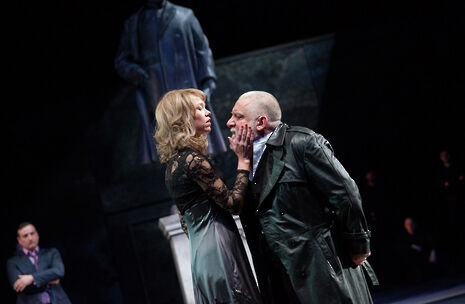Film: King Lear (National Theatre Live Encore)
Aron Penczu attends a screening of King Lear broadcast under the National Theatre’s NT Live scheme

Sam Mendes’s King Lear is exceptional. This, at least, is beyond dispute, evidenced by its haul of heavyweight 4- and 5-star reviews (and Varsity’s own, by Becky Rosenberg). Pundits have praised its superb and unconventional performances: Simon Russell Beale’s Lear especially, but also Stanley Townsend’s Kent/Caius as "an aggressive bully-boy rather than the usual pious worthy", or Anna Maxwell Martin’s Regan, "a posh nymphomaniac turned on by torture". By all accounts the play’s design – at turns opulent, at others grimly bare, and in the storm scene truly awesome – is a triumph, the lighting (and darkness) impeccable, the sound, including rain-deluges and cracking reverbations of thunder, superlative. But how does all this translate to the screen?
In brief, very well. What is curious is the resultant hybrid form, neither play nor film entirely. We get the advantages of multiple camera angles, the effective erasure of awkward set changes, close-ups even the most expensive seats could not afford. But the piece is also unmistakably dramatic. Action is limited to a single space, though one considerably altered; at its end, performers take their bows. Occasional issues with mike-snuffle when bodies press against each other are preserved. Perhaps most emblematic of all is the camera turned on the audience in the interval. In the original, live screening cinema-goers were confronted with a weird echo of themselves, counterparts eerily observed in their oblivious, more orthodox observance. Repeat showings, like the one I attended, record and re-exhibit that transient encounter. As I watched I was thinking of the technologies that made this Lear possible: projection, sound, a somewhat unnecessary hydraulic ramp in the storm scene. But these are only improvements on their predecessors: Shakespeare’s rolling cannonballs, or the much older Greek mechanē of the literal deus ex machina, redux. What has never before been possible is this real-time audience-watching, the distances it spans, the possibilities it raises. The cinema screening is both parasitical and original, a characteristically modern neither/nor.
Later in the interval we were shown a brief segment composed of interview-fragments. Here the use of the technology was less felicitous. It was fascinating to hear about Mendes’s difficulty in making Cordelia’s ‘nothing’ sound believable, and his efforts to differentiate Goneril and Regan. Both are well managed in the opening ‘division scene’. Lear is demanding and near-dictatorial, and Goneril delivers her effusions with nervous, hesitant inauthenticity. Regan performs for him, kisses him, sits coquettishly in his lap. And when Cordelia refuses to join in their play-acting Lear’s is an over-reaction, incongruously angry, causing his audience to flinch as he overturns tables and chairs. But to explain this is to make a ploy for our sympathy, too transparent to be fully successful. If it aspires to equal status as an artwork with the theatrical showing then this cinematic version should not stoop to self-justification. And to trace Simon Russell Beale’s doddering, stooped, shuffling Lear to Lewy body dementia, to suggest he is channelling the specific symptoms identified by a scholarly paper as Lear’s possible disease, is surely to subtract from the power of that performance.
Indeed, it was in the medical Lear, hospital-gowned, that the piece fell short of its promise. Wearing a hat ringed with flowers, he is a gentle, deluded old man, more pathetic than tragic. Earlier we had seen him mad. Adrian Scarborough’s Fool, who kisses Cordelia’s hand at the end of the opening and allows Lear to bury his face in his shoulder in the storm, is remarkable enough to deserve mention. So much of the play’s tragedy seems contained in the sympathy and wisdom with which he meets his equally old and weary master’s eyes. And the production’s solution to the problem of the Fool’s disappearance – Lear, deranged, beats him to a bloody pulp – may be its best moment, the hovel scene its true climax. Here, there is terror, and pain. The same is not true in the scene of Cordelia’s death. Perhaps it is in its effort to outdo and circumvent previous productions that Mendes’s King Lear ends with an unexpectedly underwhelming finale, and if so, it’s unfortunate that it should fail after succeeding so incontestably until this point.
But the play, or the play-film, remains memorable. National Theatre Live may represent a new niche in the performing arts: King Lear, sold out through several encores at the Cambridge Picturehouse, is proof enough of its potential.
 News / Fitz students face ‘massive invasion of privacy’ over messy rooms23 April 2024
News / Fitz students face ‘massive invasion of privacy’ over messy rooms23 April 2024 News / Climate activists smash windows of Cambridge Energy Institute22 April 2024
News / Climate activists smash windows of Cambridge Energy Institute22 April 2024 News / Copycat don caught again19 April 2024
News / Copycat don caught again19 April 2024 Comment / Gown vs town? Local investment plans must remember Cambridge is not just a university24 April 2024
Comment / Gown vs town? Local investment plans must remember Cambridge is not just a university24 April 2024 News / Emmanuel College cuts ties with ‘race-realist’ fellow19 April 2024
News / Emmanuel College cuts ties with ‘race-realist’ fellow19 April 2024




